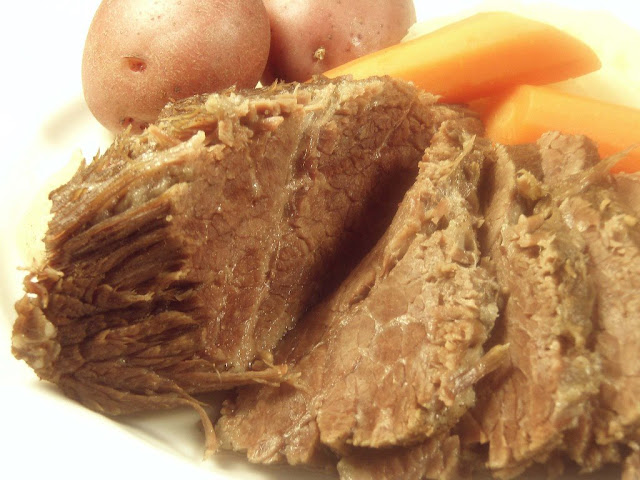Okay friends, if you're going to cure your own brisket for St. Patrick's day Corned Beef and Cabbage, you need to start TODAY. That baby needs at least 5 days of salt-curing before even going into the pot. I may not be of Irish descent, but one of the great things about growing up in New York is that no matter where your parents are from, having Corned Beef on St. Patrick's day (or any day of the year for that matter) can be just as close to your heart as Roast Pork on Chinese New Year. I'm drooling already, just thinking of Reuben sandwiches and fresh corned beef hash I'm going to make from the leftovers. Even though it's one of my favorite foods, this is the first time I've ever made Corned Beef (yeah, you boil it for a really long time, not rocket science) let alone cured my own brisket. So I started curing a brisket earlier this week for a test run.

Corned beef is basically a brisket that has been preserved in salt (and spices). Incidentally, pastrami is simply corned beef that has been smoked. As with most foods that originated out of necessity (before refrigeration and refrigerated transport of course) we still continue this tradition for love of the the unique flavor and texture that salt-curing imparts. The tradition of having corned beef and cabbage on St. Patrick's Day is apparently of American origin. According to the history channel, Irish Americans in the late 1800's substituted corned beef for the bacon that would have been traditional to their homeland.
For my maiden voyage into making Corned Beef and Cabbage, I went to my most reliable source - America's Test Kitchen Family Cookbook. I used their recipes for both the cure and the cook and true to their word, it was practically foolproof and had really great flavor. Oh, by the way I didn't have plain paprika on hand, so I used smoked paprika, which added just a hint of smokiness. One of the things about home-curing your brisket, of course, is being able to control the seasoning - a longer cure will result in a more flavorful brisket but too long a cure and it will be overly salty. I went with a 5 day cure myself and after taking the cured brisket out of the ziplock bag, you could even feel the difference. I was fortunate enough to find a thicker well-marbled point cut brisket (as opposed to the thinner and leaner flat cut that is more widely available). After curing, the once supple bright red piece of organic Whole-Foods, locally raised brisket had released most of it's moisture and was firmer, almost leathery. This was a good sign of course.
As directed I simmered that sucker for 3 hours after which the recipe says a fork should slide easily into the center of the meat. Hmm. not quite. It probably could have gone longer, since it would take much longer to overcook the brisket to the point that it would fall apart, but I thought a little resistance was better for slicing - and it was fine. It sliced really nicely across the grain and the flavor was spot on.
By the way, the recipe calls for a 3-1/2 to 4-1/2 lb. brisket, but between curing and cooking, there is a lot of shrinkage, so it's actually not as much meat as it sounds like. Oh, and don't worry if your home-cured corned beef is not as pink as store bought - you won't miss those nasty nitrates and nitrites that are sometimes commercially added to preserve color.
SOURCE: Adapted from the America's Test Kitchen Family Cookbook
YIELD: Approximately 8 servings
INGREDIENTS:
for the cure:
1/2 c. kosher salt
1 Tbsp. cracked black peppercorns
1 Tbsp. dried thyme
2 tsp. allspice
2 tsp. paprika (or try smoked paprika)
2 bay leaves, crumbled
1 3-1/2 to 4-1/2 lb. beef brisket, trimmed
for cooking:
3 bay leaves
1 Tbsp. whole black peppercorns
1 Tbsp. whole mustard seeds
. Water
1-1/2 lbs. baby red or baby yukon gold potatoes
1-1/2 lbs. carrots, peeled and cut into thirds
1 2 lb. head of cabbage, cut into 8 wedges
Spicy deli-style mustard, for serving (I prefer Koscuisko brand for it's sharp horseradish-y flavor)
PROCEDURE:
1. Cure the brisket. Mix all the salt and spices together in a small bowl. Spear the brisket 30 times on each side with a meat fork or metal skewer. Rub each side evenly with the salt mixture then place it in a ziplock bag, forcing out as much air as possible. Put the brisket on a rimmed baking sheet and cover with a second one. Tape or tie the whole thing together and weigh it down with two bricks or large cans. Refrigerate, weighted, for 5 to 7 days. Rinse and pat the meat dry before cooking.
2. To cook the brisket, add the corned beef, bay leaves, peppercorns, and mustard seeds in a large dutch oven or pot and cover by a 1/2 inch of water. Simmer for 2-3 hours until a fork slides easily into the center of the meat.
3. Transfer the meat and 1 cup of liquid to a baking dish and keep warm in a 200 degree oven while you cook the vegetables. Add the potatoes and carrots to the cooking liquid left in the pot and simmer until they begin to soften (10 minute). Then add the cabbage and simmer 10-15 minutes more or until all the vegetables are cooked.
4. To serve, remove the meat from the liquid and slice against the grain. Arrange the meat on a platter with the cooked vegetables and moisten with additional cooking liquid. Serve with spicy mustard on the side.
Note: Spearing and weighting down the brisket are essential steps for proper curing. I tried this once forgetting these steps and the cure didn't take so the brisket became rancid. Not pretty nor edible.

No comments:
Post a Comment